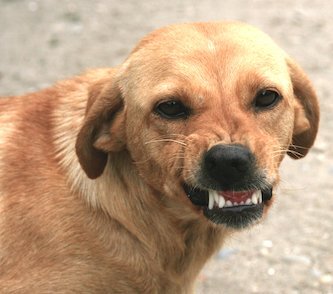Why is my Sweet Dog so Aggressive to People Outside of Our Family?
©Scott Sheaffer, CDBC, CBCC-KA, CPDT-KA, USA Dog Behavior, LLC
Almost everyone who owns a dog that is aggressive to people outside of the family asks me some form of the following question, “Why is my dog such a great and loving pet with our family but is so vicious and aggressive with people outside of our family?”
Let me answer that question by first telling you what is not causing this behavior. While it may look like your dog is protecting you, your family or your home, that is not the case. It may appear that way, but your dog is actually acting aggressively for a reason that is probably 180 degrees different than what you think. To read more about why people come to this conclusion please see Do Dogs Instinctively Protect Their Owners?
“Only treating the aggressive behaviors instead of the root cause normally causes the aggression to get worse.”
The actual root cause for this behavior is surprising to most dog owners (and to many dog trainers for that matter). The real cause is fear. That’s right, fear. Dogs that are aggressive to strangers (i.e., non-family members) are afraid of the stranger. The aggression is an attempt by the dog to create distance between them and the scary human. More distance is what the dog wants in order to feel safe.
About 90% of dogs use aggression to keep scary unfamiliar humans away while some dogs use avoidance. Dogs avoid scary humans by moving away from them, thus creating more distance. Avoidance and aggressive behaviors are collectively called distance increasing behaviors. In both cases, the dog is trying to create more distance in order to feel safe.
It’s so hard for some owners of Doberman Pinschers, Rottweilers, German Shepherds, Pitbulls, etc. to believe their powerful breed is actually scared of the 100-pound elderly lady coming into their home. But they are. There are many reasons how this fear developed including, but not limited to, genetics, lack of proper socialization at critical developmental stages, human abuse, etc.
Exactly why don’t these dogs show aggression to family members*? The simple answer is that they are very familiar with the family members and have learned not to fear them. Most of these dogs are absolute snuggle-bugs with family members including the children. But the moment a stranger walks in the door - these dogs send an unequivocal message that this person needs to leave immediately.
Treating just the aggressive behaviors (e.g., barking, growling, biting) will sometimes temporarily suppress these behaviors but doesn’t address what is causing these symptoms (i.e., fear). The aggressive behaviors are actually an indicator of the real problem (i.e., fear), but are not the root cause.
Addressing only the aggressive behaviors is not unlike taking pain killers for a serious illness and assuming everything is fine since the pain is reduced. Only treating the aggressive behaviors instead of the root cause normally causes the aggression to get worse (see, Pretenders Who Claim to Treat Aggressive Dogs, Buyer Beware). The fear has to be properly addressed through desensitization and counter conditioning by an independently certified canine behaviorist who specializes in this type of behavior.
Aggression toward humans by dogs is very challenging to treat, but it can in many cases be improved enough for the dog to be a more functional dog around non-family members. Understanding the motivation for the aggression is the starting point for owners who undertake behavior modification for this kind of dog.
*Please note, there are some types of canine aggression that are expressed toward family members.

